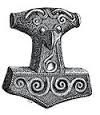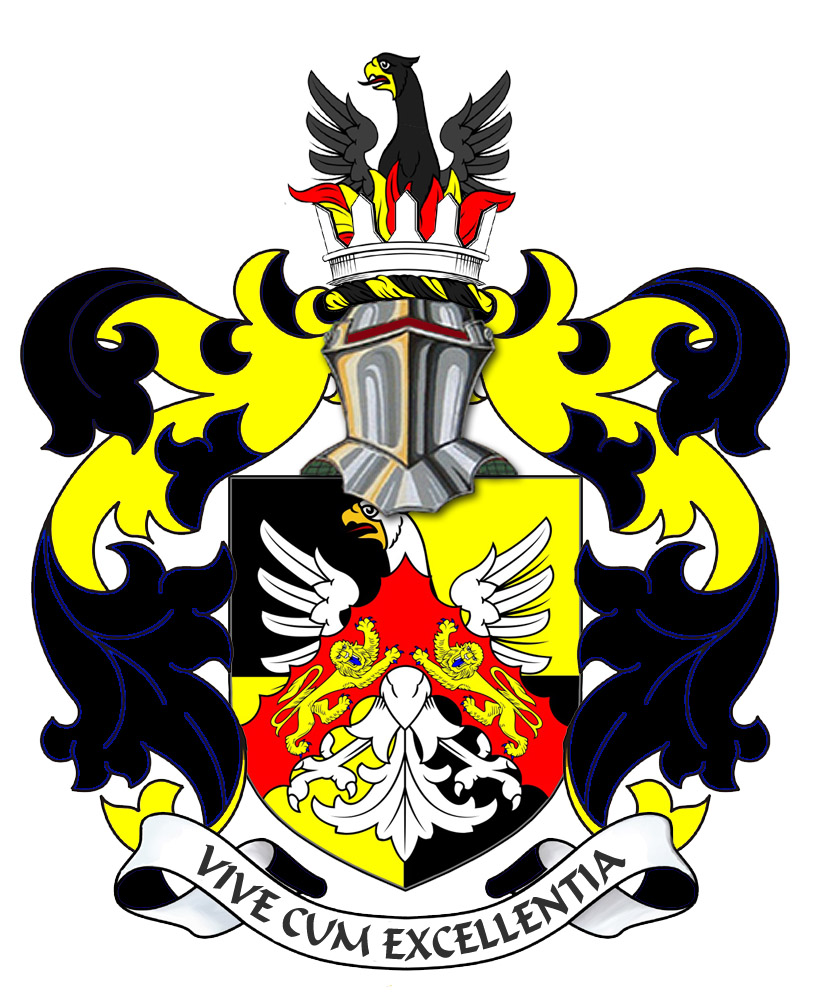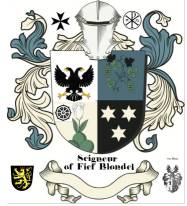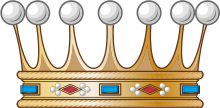


The Feudal Principality of Annaly-Longford: Eight Centuries of Regalian SovereigntyIntroduction: The Nature of Feudal Property RightsIn the landscape of medieval and early modern Europe, territorial sovereignty was not merely a matter of governmental recognition but a complex web of property rights, hereditary dignities, and jurisdictional privileges that could be granted, inherited, bought, and sold. These feudal rights—what English common law terms "incorporeal hereditaments"—functioned much like modern intellectual property, mineral rights, or corporate shares: intangible interests that nonetheless constituted genuine property capable of legal transfer. The story of the Barony and Principality of Annaly-Longford exemplifies this principle, tracing an unbroken chain of feudal sovereignty from the Norman conquest of Ireland through eight centuries to the present day. The Norman Foundation: De Lacy, De Nugent, and the Lordship of Meath (1172-1202)The legal foundation of what would become the Feudal Principality of Annaly begins with the Norman invasion of Ireland in 1172. King Henry II of England, seeking to reward and control his Norman knights in the newly conquered territory, granted to Hugh de Lacy the vast Lordship of Meath, to be held by the service of fifty knights. This was no ordinary fief. The Lordship of Meath carried extraordinary regalian privileges—including jurisdiction over the four royal pleas of arson, forestalling, rape, and treasure trove—powers typically reserved to the Crown itself. In essence, De Lacy held a palatinate, a quasi-sovereign territory within the realm where the lord exercised near-royal authority. Around 1202, Hugh de Lacy granted to his chief retainer, Sir Gilbert de Nugent, the extensive lands of Delvin (Delbhna), creating the Barony of Delvin. This conveyance established the Nugent family as hereditary barons governing the western marches of Meath and the borderlands adjoining the Gaelic O'Farrell territory. The Nugents inherited not merely land but jurisdictional authority—the power to administer justice, command military forces, and govern both Norman settlers and Gaelic vassals under the quasi-regal framework established by the De Lacys. Integration and Consolidation: The Delvin Barons as Frontier Lords (13th-15th Centuries)Throughout the medieval period, the Barons Delvin occupied a unique position as intermediaries between the English Pale and the Gaelic west. Their lands encompassed territories of ancient Gaelic clans—the O'Fenelon and O'Skully chiefs of Teffia (Tethba), the precursor to modern County Longford. Rather than simply displacing these native lords, the Nugents incorporated them as vassals within a hybrid feudal-Gaelic structure, blending Norman seignorial administration with Irish lordship customs. By the fifteenth century, the Barons Delvin had emerged as the preeminent hereditary nobility of Westmeath, functioning as local governors for the Crown. In 1401, William Nugent, Baron Delvin, served as Sheriff of Meath, administering royal justice throughout the region. This office confirmed that the Nugents exercised viceregal jurisdiction within the western Pale, acting not merely as landholders but as representatives of royal authority itself. Tudor Recognition: Military Command and Quasi-Sovereign Authority (1494-1550)The Tudor monarchs, seeking to strengthen royal control over Ireland while managing the turbulent frontier between the English Pale and Gaelic lordships, recognized the Nugents' strategic importance and formalized their military and governmental powers through a series of extraordinary appointments. In 1494, Gilbert Nugent, Baron of Delvin, received appointment by Henry VII as Chief Captain of the King's Forces in Ireland, commanding a salary of £200 yearly—a princely sum. This commission placed him in charge of all royal troops throughout the island, effectively making him the Crown's Captain-General, an office of princely command comparable to the great military governorships of continental Europe. Two years later, in 1496, Richard, 7th Baron Delvin, was made Commander and Leader-in-Chief of all Forces of Dublin, Meath, Kildare, and Louth, further cementing the family's position as quasi-sovereign military authorities over much of eastern Ireland. These appointments were not honorary titles but genuine delegations of royal military power. The Barons Delvin commanded troops, suppressed rebellions, negotiated with Gaelic lords, and defended the Pale's borders—all functions typically reserved to princes or viceroys. In effect, the Tudor Crown recognized the Nugents as feudal princes within their domains, exercising sovereign authority on behalf of the monarch. The Absorption of Annaly: Crown Grants and Territorial Expansion (1552-1565)The sixteenth century witnessed the systematic absorption of the ancient Gaelic principality of Annaly (Anghaile) into the Nugent estates through a series of strategic Crown grants. Annaly, historically ruled by the O'Farrell Princes, encompassed the modern County Longford and portions of Westmeath—a territory of immense strategic and economic importance on the Pale's western frontier. In 1552, King Edward VI granted to Baron Delvin extensive estates within Annaly, including the Monastery and Holy Island of Inchcleraun on Lough Ree and the Priory of Inchmore on Lough Gowna. These were not merely ecclesiastical properties but strategic strongholds symbolizing sovereignty over O'Farrell territory. The grants specified that these lands were held "in capite by knight's service"—a feudal formula indicating direct tenure from the Crown with attendant military and jurisdictional obligations. Subsequent charters by Philip and Mary (1556-1557) dramatically expanded the Delvin estate to include Abbeylara Town, Granard, Columbkille, and the surrounding demesnes of the Annaly heartland. Crucially, these grants predated the formal creation of County Longford, demonstrating that the Crown recognized the Nugents as feudal lords of Annaly before it existed as an administrative county. The family was not merely receiving land within a county but acquiring sovereignty over a region that would later be organized into a county. The capstone of this territorial expansion came in 1565 when Queen Elizabeth I granted to Christopher Nugent, Baron Delvin, the "Captainship and Chiefship of Slewaght William" (Clan Liam)—a hereditary captaincy over the eastern Annaly region centered on Ardagh and Edgeworthstown. This patent represents a fascinating fusion of English feudal and Gaelic legal concepts. In Irish law, the titles of Captain (Taoiseach) and Chief denoted sovereign tribal leadership—authority over local clans, collection of taxes and tributes, and jurisdiction in civil and ecclesiastical matters. By granting these titles through royal patent, Elizabeth I effectively transformed the Gaelic chieftainship into an English feudal dignity while preserving its substantive powers. Baron Delvin became, in both legal systems, the Prince and Feudal Chief of Eastern Longford. Economic and Judicial Sovereignty: Markets, Fairs, and Courts (1605-1620)If territorial grants and military commands established the Nugents' princely status, the economic and judicial franchises granted by James I confirmed their quasi-sovereign authority over the daily life and commerce of Annaly-Longford. In 1605, King James I issued a market and fair charter to Baron Delvin, granting the right to hold a weekly Thursday market and an annual fair on August 1st at Longford, together with all accompanying courts baron, courts leet, tolls, and profits. This franchise was far more than a commercial privilege. The power to establish markets and fairs was a regalian right—a sovereign prerogative that the Crown typically reserved to itself or delegated only to its greatest lords. The associated courts baron and courts leet conferred comprehensive civil and criminal jurisdiction over the market town and surrounding territory. The court baron handled disputes between tenants and matters of land tenure; the court leet exercised criminal jurisdiction over minor offenses and maintained public order through the "view of frankpledge," a police power ensuring that all free men were organized into mutual security groups. This grant symbolized royal recognition of Longford—the ancient Longphort Uí Fhearghail (fortress of the O'Farrells)—as the capital seat of Annaly, with the Baron Delvin as its feudal overlord, market lord, and chief justice. Between 1609 and 1620, James I reissued and expanded these grants, reaffirming the Nugents' rights "in capite by military service" to the lands, abbeys, and castles of Annaly, including Liserdawle (the ancient seat of the Princes of Annaly), Smere, Columbkille, Lisgarry, Aghagagh, Abbeylara, Templemichael, Rathline, and Cashell. Each grant explicitly carried courts leet, view of frankpledge, power to appoint seneschals (estate stewards with judicial functions), advowsons (the right to appoint clergy to church benefices), and jurisdiction in civil actions—the complete apparatus of feudal sovereignty. The Charter of 1609 effectively confirmed the Seignory of Annaly-Longford as a feudal liberty held directly from the Crown, preserving all the regalian rights that transformed the Barons Delvin from mere landowners into territorial princes. Elevation and Recognition: The Earldom of Westmeath and Papal Acknowledgment (1621-1635)In 1621, King James I elevated Richard Nugent, 9th Baron Delvin, to Earl of Westmeath, formally uniting the Delvin and Annaly-Longford territories under a single comital dignity. This elevation recognized not merely the family's accumulated landholdings but their de facto princely status—their exercise of military, judicial, and economic sovereignty over a substantial territory on Ireland's western frontier. Remarkably, even the Papacy acknowledged this sovereignty. In 1635, Pope Urban VIII issued a decree permitting the Earl of Westmeath to retain possession of the Monastery and Island of Inchmore "for as long as the schism should last"—a reference to England's separation from Rome. This papal recognition of feudal and proprietary sovereignty over ecclesiastical property was extraordinary, effectively treating the Earl of Westmeath as a temporal prince whose territorial rights transcended the religious conflict between Protestant England and Catholic Rome. The Legal Character of the Annaly Seignory: Feudal Barony or Principality?The cumulative effect of these grants—spanning more than four centuries from the De Lacy-Nugent fief of 1202 through the Jacobean confirmations of 1620—establishes that the Lordship of Annaly-Longford functioned as a regalian seignory: a jurisdiction held directly from the Crown (in capite) with full sovereign powers including courts, markets, military command, ecclesiastical patronage, and hereditary authority over local clans. By the technical definitions of English feudal law, this constitutes a feudal barony—a territorial lordship with jurisdictional privileges beyond those of an ordinary manor. However, by Irish legal tradition and Continental European analogy, the dignity amounted to a feudal principality. The holder—the Baron Delvin, later Earl of Westmeath—embodied both baronial and princely status, functioning as fons honorum (source of honors) and captain of the Pale's western frontier. The Nugents exercised powers comparable to the Prince-Bishops of Durham in England, the Counts Palatine of the Rhine, or the great territorial princes of the Holy Roman Empire. The Gaelic Inheritance: Succession to the O'Farrell PatrimonyThe significance of the Nugent lordship over Annaly-Longford extends beyond English feudal law to encompass the ancient Gaelic princely dignities that preceded Norman conquest. The region had been ruled for centuries by the O'Fearghail (O'Farrell) dynasty, Princes of Anghaile, together with a constellation of noble septs: O'Quinn (Ó Cuinn) of Rathcline, Mac Gilligan (Mac Giollagáin) of Muintir Gilligan, O'Mulfeeney (Ó Maolfhíneadha) of Corcard, O'Duignan (Ó Duibhgeannáin) of Ardagh, O'Skelly (Ó Scealláin) and O'Skully (Ó Scolaighe) of South Teffia, O'Reilly (Ó Raghallaigh) and O'Murray (Ó Muireadhaigh) on the eastern borders, Mac Donough (Mac Donnchadha) and O'Hanley (Ó hAinle) near Lough Ree, and the O'Fenelon (Ó Fionnaláin) chiefs of the ancient Delbhna or Delvin tribes of Western Westmeath. These families collectively formed the hereditary nobility of the old kingdom of Teffia, later known as the Principality of Annaly. Through the Tudor and Stuart Crown grants, the Nugents became not merely English feudal lords but successors to this Gaelic princely patrimony. They acquired the traditional seats of O'Farrell sovereignty—Granard, Abbeylara, and Liserdawle—and received formal investiture as captains and chiefs over the Gaelic clans. In both English feudal law and Irish Brehon tradition, they stood as the legitimate heirs to the ancient principality. Modern Implications: The Continuity and Transferability of Feudal RightsThe historical record establishes an unbroken chain of feudal sovereignty over Annaly-Longford spanning more than eight centuries. These rights were not ephemeral governmental appointments but property interests—incorporeal hereditaments—that passed by inheritance through the Nugent family from the thirteenth century through the modern era. The critical legal principle is this: while the Irish and British governments have abolished the governmental functions historically associated with feudal titles—no modern Earl of Westmeath can convene a court leet, levy market tolls, or command military forces—the titles themselves remain property capable of ownership and transfer. Just as copyright persists even when the commercial value of a work diminishes, just as mineral rights exist independently of whether mines operate, feudal dignities survive as property rights regardless of whether their original governmental functions remain enforceable. When William Anthony Nugent, Earl of Westmeath, sold the feudal rights associated with the Barony and Seignory of Longford in 1996, he was conveying a legitimate property interest supported by nearly 800 years of documented legal title. The subsequent purchase of these rights by George Mentz, Seigneur of Blondel, represents a valid transfer under common law principles governing the sale of incorporeal hereditaments. The fact that the Republic of Ireland does not recognize these titles as conferring governmental authority is legally irrelevant to the question of ownership. Ireland's non-recognition of feudal privileges is analogous to a government's refusal to honor a historical currency—the currency notes still exist as collectibles even if they no longer function as legal tender. Similarly, the titular and honorific rights to the Barony and Principality of Annaly-Longford persist as property regardless of governmental recognition. Conclusion: The Enduring Legacy of Feudal SovereigntyThe Barony and Principality of Annaly-Longford stands as a remarkable example of how feudal property rights, properly understood, transcend the governments that originally created them. From the Norman partition of Meath in 1172 through the Jacobean confirmations of the seventeenth century, the Nugents of Delvin and Westmeath built and preserved a genuine feudal sovereignty—a territorial lordship with military, judicial, economic, and ecclesiastical jurisdiction rivaling that of the great princes of medieval Europe. That sovereignty was not merely a governmental appointment subject to revocation but a property interest, granted in perpetuity, passing by inheritance, and capable of sale and transfer. The Crown grants creating the lordship used the language of permanent conveyance: lands and rights held "in capite," "in fee simple," "to him and his heirs forever." These were not leases or licenses but grants of property in the fullest legal sense. The modern holder of these rights—whether the Earl of Westmeath's successors or subsequent purchasers—possesses not governmental power but something perhaps more enduring: a documented legal claim to one of Ireland's great feudal dignities, a title connecting its bearer to eight centuries of Irish and European history, and a property right as legitimate as any deed, patent, or copyright in modern law. The question is not whether the Irish government recognizes these rights—it does not and need not. The question is whether the historical chain of title is sound, whether the property interests were validly created and transferred, and whether modern law permits the continued ownership of such incorporeal hereditaments. On all these points, the legal and historical record is clear: the titular rights to the Barony and Principality of Annaly-Longford exist as property, have been lawfully transferred, and continue to vest in their current holder regardless of any government's opinion on the matter. In an age that often dismisses feudal titles as mere anachronisms, the story of Annaly-Longford reminds us that property rights, once properly established, possess remarkable durability. They survive governments, outlast ideologies, and persist through centuries—not because any authority recognizes them, but because the law itself, properly understood, protects the ancient principle that what one legitimately owns, one may legitimately convey to another.
In authentic Irish, the word “of” is implied through the genitive, not stated.
| ||||||||||||||||||
Seigneur de la Fief of Blondel Lord Baron Mentz of Fief Blondel Geurnsey Crown Dependency Seigneur Fief of Blondel George Mentz Lord Baron of Fiefdom Blondel Freiherr of Fief Thomas Blondel Feudal Lord of Baronnie - Noble Fief Barony Friherre > Prince of Annaly Teffia Seigneurs and Dames Travel Research Lord Paramount Feudal Barons The Seigneur Order Patron George Mentz Charter of Liberties Deed & Title Fief Blondel Islands Viking Kingdom Fief Worship Fiefs of the Islands ECS Extended Continental Shelf Styles and Dignities Territorial Waters Blondel Privy Seal Fief Bouvees of Fief Thomas Blondel Guernsey Court of Chief Pleas Fief Court Arms Motto Flower Fief de l'Eperon La Genouinne Kingdom of West Francia Fief DuQuemin Bouvée Phlipot Pain Bouvée Torquetil Bouvée Bourgeon Bailiwick of Ennerdale Channel Island History Fief Direct from the Crown A Funny Think Happened On the Way to the Fief Guernsey Bailiwick of Guernsey - Crown Dependency Confederation des Iles Anglo-Normandes Sovereignty Papal Bull Research Links Norse Normandy Order of the Genet Order of the Genet Order of the Star Est. 1022 Knights of theThistle of Bourbon Count of Anjou Fief Rights Blondel and King Richard Press Carnival Manorial Incidents Appointments of Seigneurs Store Portelet Beach Roquaine Bay Neustrasia Columbier Dovecote Fief Blondel Merchandise Fief Blondel Beaches Islands Foreshore Events Fiefs For Sale Sold Lords of Normandy Fief Coin Viscounts de Contentin Fief Blondel Map Feudal Guernsey Titles Board of Trustees The Feudal System Hereditaments Chancellor Flag & Arms Fief Videos Guernsey Castle Sark Contact Advowson Site Map Disclaimer Freiherr Livres de perchage Lord Baron Longford Income Tax Guernsey Valliscaulian Order Saint Benedict of the Celestines Society of Divine Compassion Dictionary Count of Mortain Seigneur de Saint-Sauveur Seigneur of Fief Ansquetil Top Success Books Datuk Seri George Mentz Order St. Benedict OSB Celestines Order of the Iron Crown Order of the White Falcon Colonel Mentz Order Red Eagle Order St. Louis Order Holy Ghost Order of Saint Anthony Order of the Black Swan Order of St Columban Order of the Iron Helmet Livonian Brothers of the Sword Fief treizième and Direct from Crown Valuation Fief Blondel Prince of Annaly Teffia
Feudal Lord of the Fief Blondel of the Nordic Channel Islands Guernsey Est.
1179
Feudalherr - Fief Blondel von der Nordischen Insel Guernsey Est. 1179
New York Gazette - Magazine of Wall Street -
George Mentz -
George Mentz - Aspen Commission - Mentz Arms
Counselor George Mentz Esq. - Seigneur Feif BlondelBaron Annaly Baron Moyashel Grants to Delvin About Longford Styles and Dignities The Seigneur Court Barons Fiefs of the Islands Longford Map The Island Lords Market & Fair Fief Worship Channel Island History Fief Blondel Lord Baron Longford Fief Rights Fief Blondel Merchandise Events Blondel and King Richard Fief Coin Feudal Guernsey Titles The Feudal System Flag & Arms Castle Site Map Disclaimer Blondel Myth DictionaryMentz Scholarship Program 101 Million Donation - Order of the Genet Knighthood |





George Mentz Education -
Commissioner George Mentz
-
https://finance.yahoo.com/news/commissioner-george-mentz-clinches-influencer-180000705.html
-
George Mentz News -
George Mentz Net Worth - George Mentz Noble Tilte -
George Mentz -
George Mentz Trump Commissioner -
George Mentz Freiherren Count Baron -
George Mentz Global Economic Forum -
George Mentz Donates Millions